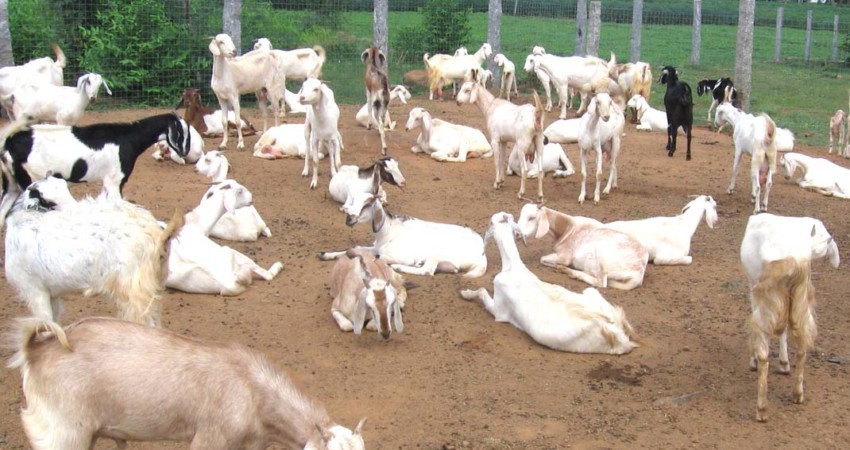

The saying that “do not kill the goose that lays the egg” comes to life when you get to Majengo Village, Kamukuzi Division in Rwebikoona, in Mbarara Town where a 25-year-old goat shed sits.
This is a shed housing more than 70 goats which started as one goat given to 63-year-old Herbert Kabandize as a donation from his father.
Rather than eat it or sell it for quick money, the father of 10 kept the goat which kept producing goats that he has kept selling off until today where he maintains a herd of 70 goats.
Kabandize’s trick
There is always the temptation to think that to rear goats, one needs a sizable chunk of land where to graze the goats, Kabandize, however, has a makeshift wooden shed measuring approximately five metres wide and seven metres long, made in simple wood work.
How he started
According to Kabandize in 1994, when he got the goat, it first produced one kid. The second time it produced two and since then it continued multiplying the numbers until they reached 50.
Despite having children who were of school going age, Kabandize did not sell any of the goats to pay fees for the elder children until 2001 when he sent the fifth born and the remaining five younger children to school.
He says every term he sells between six and eight goats to pay school fees for the children. Each goat costs between Shs150,000 and Shs250,000.
Feeding
To feed the goats, he does not need grass to graze the goats. He collects banana peelings from hotels and neighbours.
To supplement their diet, he usually releases them to go and eat grass for a few hours and the goats are brought back to their shade.
Kabandize’s dream is to have up to 200 goats because they have managed to help him with school fees.
His fifth born Peace Busingye sat Senior Six examinations last year and has been admitted to Makerere University to pursue a Bachelor of Literature in Education and the parents hope to raise the tuition from their farm.
Innovative
Besides selling goats, Kabandize also farms bananas and other crops. He uses the compost from his goats to fertilise his soils.
“It is only that most farmers may not be aware, goat manure can be composted and used as mulch and it can prevent about 90 per cent water lose from the soil for crops use, especially during dry seasons,” Kabandize says.
In addition, the manure is more nutritious to crops compared to other types of livestock manure because the goats like feeding on herbs which is fully digested hence their droppings are less messy than many other types of manure.
“Goat manure contains a high content of nitrogen compared to cows, sheep, and chicken manure.
This nitrogen further enhances the growth of plants and crops by nitrogen fixation, hence it increases the yield of crops by at least 20 per cent,” Kabandize says.
Challenges
Asked about the challenges he faces when raring goats, Kabandize says rearing goats is not a problem
save for infections in the intestines which require regular deworming. For all his children studying between Primary Three and Senior Four, it is selling of the goats that is paying their tuition.
He pays more than Shs1.2m as school fees for his three children. One attends Primary Seven, the other Primary Four and one in Senior Four.
The structure
The house should be raised 1.5 feet above the ground. A slatted wooden floor is very important with small gaps about half an inch wide (or the width of a slide of a match box between the planks or rafters).
Local materials such as off-cut planks can be used. Floor racks made of rafters should be put where the goats feed and sleep to stop foot rot when it is wet. This helps to keep the house dry.
Tips for a good shelter
A good goat house will make it easy to keep goats and should therefore be:
•Rain proof
•Damp proof
•Well ventilated
•Free from direct wind
•Free from sharp objects that might cut the goat
•Pest and wild animal proof
•Slats on floor for free fall of droppings
The benefits of such a goat house are that you will:
•Prevent the animals from much disease.
•Ensure controlled breeding and eliminate many instances of breeding
•Feed the animals very easily and minimize feed wastage
•Save the goat from wasting energy and increase the amount of milk you get
•Keep the goat’s feet dry and clean all the time
There are two main areas of the goat house, the sleeping area and the feeding area.
Sleeping area
•Have walls all around with a door to allow the goats in and out
•Should be roofed to prevent rain
•Should be well ventilated with lots of air allowed in
Feeding area
•This is an open compartment without a roof for the goats to get some sun
•It is fenced right
With a door or gate
•Feed and water trough are placed here
•Feed racks for hanging fodder
•Slatted floor to let manure fall through helps to keep the feet and animals clean and dry
•Mineral blocks are placed where rainfall cannot reach but are easily accessible to the goats.
Next Reading
How to inspect a honey bee hive.
Inspect your beehive on a regular basis but not too often. For beginners, every seven […]
Previous Reading
Importance of a healthy Gut in Pigs
Just like humans, having good gut health is important for the overall health of a […]
 Contact Jaguza Support
Contact Jaguza Support